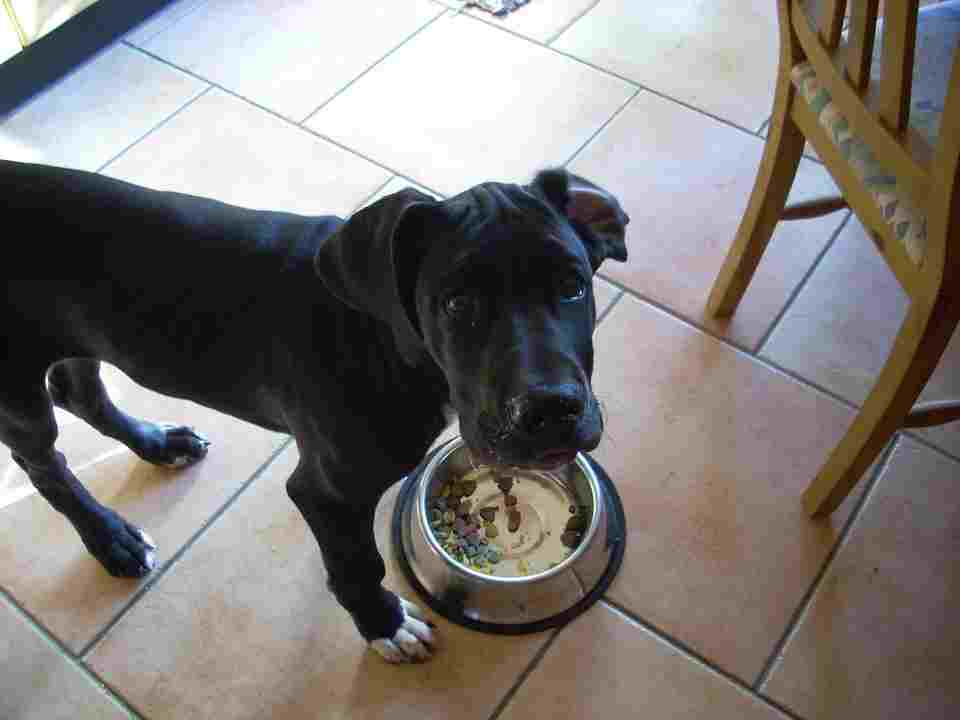Crate training isn’t the easiest task when it comes to dog home training, it takes consistency and patience, so here are 11 crate training tips that will help you do it efficiently.
But before we expose our tips you should already have a step by step program to follow that you can enhance by these crate training tips. I suggest you check out my explicit guide on the matter.
1-Crate training at a young age
This could be the most useful of all these crate training tips we are about to see.
This is a conclusion I came to myself; all dogs that I’ve crate trained at a younger age were more receptive to training.
And it takes significantly less time to do it, than older or adult dogs.
There are some exceptions for adult dogs some just love the crate on the spot but mostly it takes a few weeks; while younger dogs get to like it faster.
There will be more whining and crying in the crate at night with younger puppies, but if you just ignore it, it goes away after a day or two.
Smaller dogs are less energetic and spend about 18 hours a day sleeping so they are less likely to object to the crate.
Along with being more receptive to training, starting at a young age helps a lot with the potty training and can help a lot establishing communication.
It also gives stability to the dog, so he doesn’t have to change his sleeping habits or daily routine as he grows.
So get your puppy a crate that fits his size, you can opt for a larger one with separation panel, and start training as soon as you possibly can.
For more details about the benefits of crate training at a younger age check out this article.
2-Exercising Before crate training
The crate is supposed to be a place where your dog feels safe and relax. So a dog full of energy will be less willing to get in one.
Just like we don’t feel like going to bed at 10 am, so are dogs; they sure have more sleeping hours(about 50% of their day) but they still need to get that energy down.
The best time to exercise your dog is before going to the crate, it could be active playtime.
It is better if it’s outdoor exercising, it will bring the energy down and your dog will be looking forward to his time chilling in the crate.
When you place a dog in the crate without exercise, they will object by chewing on it or continually barking.
Adult dogs need on average about two hours a day of exercise and another two of active playtime.
3-Using high value treats for rewards
There is no doubt that the treats are the way to get the puppy’s attention. They will help you reward your dog when he does something you like.
You can use them to lure your dog to the crate and keep him in there, you also can use them for potty training.
Treats are the one thing all dog trainers agree on, you really can’t make it without them.
Adult dogs are more used to verbal praise, that’s not the case for puppies, but even then, it is hard to do it with no treats.
Training treats are a great stimulator in training, they help you establish basic communication with your dogs.
Dogs are intelligent animals if they do get treats for something they’ll keep doing it, and vice versa, if there are no treats for it and you show you don’t like it they’ll just stop.
Just make sure to choose something nutritious and with natural ingredients and low in calories.
I am amazed by how cheap and how many there are out there, I would suggest the “Bil-Jac” they have natural health ingredients and they support a great cause besides they’re made in the USA last time I checked they were like 6 packs for 23$ on Amazon, you can check the price here.
What is great about those is you can use them also in scavenging games which is our next crate training tip.
4-Scavenging games
Dogs spend half their time sleeping, and another 30% awake but inactive chilling, which will be the time that we want them to spend in the crate.
The 20% that’s left is where dogs exercise, outdoor would be ideal. and the rest of the time they are on active playtime.
Of course, we sometimes can’t spend an hour in playtime so there are some games that will keep your dog active and involved without needing your direct supervision.
And that’s why we recommend scavenging games where the dog will be looking for treats around the house or the dog-proof area you’re giving him access to.
It stimulates their senses and keeps them active and busy, you can use chewing toys like the Kong and fill it with something. I mean thee are hundreds of recipes out there.
5-Food for stimulation

Food is like magic for dogs, I mean it is the happiest time of there day and it makes it one of the most influential stimulators you can use to boost your dog training.
Food must always be in the crate it is the way to get your dog calm in there for 10 minutes.
It’s with that small feeding time that you start increasing it and building on it to get the dog used to the crate.
And it associates really happy thoughts with the crate. It is literally the most crucial step in the crate training program.
Food must always be served at the same time and spaced evenly during the day, to build consistency.
You want your dog to know when to expect his meal and to be looking forward to it.
This will make him hang around the crate when he is hangry and when it’s his feeding time.
There is a little tip I use to enhance that attachment feeling whit the crate while eating. Every time I am serving food in the crate, I push the door against the crate to make a sound to which the dog gets used to. Now ly dog salivates every time he hears that sound.
6-Cleaning the crate regularly
This is much more than a crate training tip, it’s a necessity that’s is mostly overlooked.
Dog owners pay little to no interest to the crate itself. they do not clean it nor check it for potential breaking.
Just a sharp edge in the crate could drive your dog nuts and make him hate the crate. Make sure to always look for any sharp edges or broken cables. If you find some, please don’t patch it with duct tape and get a new one, there are ridiculously cheap.
I use the MidWest, the one with two doors it helps a lot when introducing the dog to his crate to have two doors and make it seem like an open space. It is folding steady meatal and has a separation panel so I don’t change crates every Two months.
I took the large one for less than 100$ with its cover which is just an amazing feature for the night to minimize the outside distractions and make the dog sleep through the night, you can check it out here.
Also, make sure you clean the crate every now and then, to make sure there are no bugs or stinking odors that could make your dog uncomfortable.
I personally change crates very often, but I deal with a lot of dogs and have contact with other people who do so it is convenient for me. For regular use, unless you invest in very super heavy duty or decorative one you should change it every year.
7-Placing the crate close to your bedroom at night
The first few days of crate training are the most difficult, especially at night, puppies often start whining when in their crate at night.
For them to feel more secure and safe I suggest placing the crate ideally in your bedroom or at least close by.
First, it will let you know when they need to go for a potting break plus you can let them feel you close when they start whining.
I place my dog’s crate across the room and keep them with me using the cover of the crate. And when they are independent enough and used to their crate I start gradually placing it away from my room.
You can’t just lock them in, place it in the kitchen and go, puppies will need to eliminate in the night and if you don’t let them do it, you will be cleaning a mess in the morning. As puppies can hold it from two to three hours only.
And if your puppy does his little business in the crate it could turn into a bad habit that’s hard to break.
So the best thing to do is keep them close to your bedroom and watch over them during the night, at least until they can control their bladder.
8-Use a playpen to break it down
Crate training at night could be hard for some dog owners, especially those who have to work full time.
My tip to you when crate training at night is to use a playpen for more room to your dog so he doesn’t feel confines. This reduces the whining and lets you sleep through the night if you want to put dog pads in there.
And you can place the crate within the playpen so the dog can get in it when he wants and gradually move to the crate alone when your dog is ready.
I suggested earlier a great crate, there is actually a playpen that connects directly to it giving you more space, You can even connect two for more space if you have a large house or want to use it in your backyard and am amazed it’s even cheaper than the crate itself, check it out in here.
9-Making a crate training schedule
This is by far a tie-breaker of all the other crate training tips for sure. I mean since I’ve started using a schedule, training has never been so effective.
I know some of you have to work or have other obligations and cant be supervising their dog every minute of the day. However, no matter how simple of a schedule it is it will help.
It’s not the schedule itself that helps, but the consistency it provides for your dog.
It’s not that hard to make one I already did that and provided the tools to adjust it to any dog and any situation whether you are at home all day or have a fulltime job.
I want you to read this article carefully and by the time you’re done I assure you you’ll have a crate training schedule for your lovely dog.
One more crate training tip; once you’ve made your puppy’s crate training schedule: stick with it.
10-Breaking the barking cycle
This crate training tip is also for the night in the crate. As you have probably guessed it is the hardest time.
Puppies may start barking during the night in the crate to be let out. It is hard for you since you have to ignore it and don’t let them out and embarrassing if you have any neighbors.
So what you want to do is to break and reward, meaning stopping the barking by using a sound or tapping on the crate. And once he stops reward, and praise your dog until he understands what you want him to do.
I personally use a long leash that I attache to the crate’s door to make a sound since I’ve placed the crate across the room.
Once he stops to investigate where the sound is coming from I praise him.
if you do this enough times, your dog will eventually stop barking in the crate at night; clearly treats make things go faster.
11-Outdoor trips
When exercising my dogs I take them on an outdoor little run, I use my bicycle and have him run with me.
This is very helpful to let that energy out and have the dog ready for his time in the crate.
Obviously, you have to do it with moderation, and make sure you’re not pushing the dog beyond his limits.
Every dog is different and size and age are to be considered, you don’t want your dog exhausted.
Some dogs will be fin with a little trip in the block others will give you a hard time catching up/
I often do this just before crate time and I just stop for potting to make sure they can relax in their crate.
Two more crate training tips
If there is something to add to these 11 crate training tips we just saw it would be consistency and patience.
patience because it’s not an easy process but it pays off really quickly and makes your dog more receptive to your demands.
And consistency because when everything is kind of predictable it makes it easy and fast to get used to this new daily routine.
For more crate training tips make sure to visit our website on a regular basis, new articles with tips from experienced dog owners and trainers are published every week.






